Gameplay
Having chosen a player-character ('Sid' or 'Sally'), the player assumes a first-person control (except during cinematic sequences) to guide Mortimer through four ecosystems (savannah, taiga, Polar Ice Cap, and desert). During travel, the player uses its cursor to revive individual animals native to the habitat, earlier identified as changed into stone figures of themselves by antagonist 'Lodius'. Upon encounter with lesser antagonists (usually cyborg-like figures employing sodium chloride against Mortimer), the cursor becomes a weapon to repel these. At the end of each level, the player encounters an anthropomorphic sentinel permitting access to the next in reward for answering a riddle, whereof the answer is always the name of a species revived by the player. After the fourth level ('desert'), the game depicts Lodius' fortress, where the player-character itself must travel a series of mazes unaccompanied by Mortimer. Having overcome the maze and answered a final riddle (whereto the answer may be Lodius; Mortimer; or their common mentor, Prof./Dr. Laslow), the player rejoins Mortimer, whereupon Lodius, attempting to petrify the player-character, changes himself into a statue, with which the protagonists return to the beginning.

Baldur's Gate is a series of role-playing video games set in the Forgotten Realms Dungeons & Dragons campaign setting. The series has been divided into two sub-series, known as the Bhaalspawn Saga and the Dark Alliance, both taking place mostly within the Western Heartlands, but the Bhaalspawn Saga extends to Amn and Tethyr. The Dark Alliance series was released for consoles and was critically and commercially successful. The Bhaalspawn Saga was critically acclaimed for using pausable realtime gameplay, which is credited with revitalizing the computer role-playing game (CRPG) genre.

The Mickey Mouse universe is a fictional shared universe which is the setting for stories involving Disney cartoon characters, including Mickey and Minnie Mouse, Donald and Daisy Duck, Pluto and Goofy as the primary members, and many other characters related to them, being most of them anthropomorphic animals. The universe originated from the Mickey Mouse animated short films produced by Disney starting in 1928, although its first consistent version was created by Floyd Gottfredson in the Mickey Mouse newspaper comic strip. Real-world versions also exist in Disneyland and Tokyo Disneyland, called Mickey's Toontown.
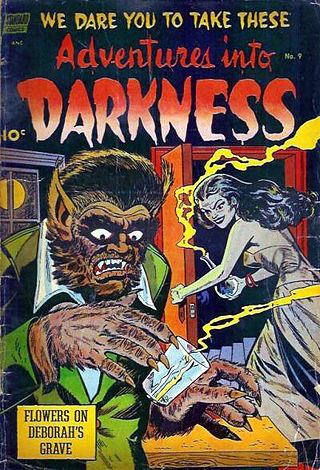
Werewolf fiction denotes the portrayal of werewolves and other shapeshifting therianthropes, in the media of literature, drama, film, games and music. Werewolf literature includes folklore, legend, saga, fairy tales, Gothic and horror fiction, fantasy fiction and poetry. Such stories may be supernatural, symbolic or allegorical. A classic cinematic example of the theme is The Wolf Man (1941) which in later films joins with the Frankenstein Monster and Count Dracula as one of the three famous icons of modern day horror. However, werewolf fiction is an exceptionally diverse genre, with ancient folkloric roots and manifold modern re-interpretations.

Curse of the Azure Bonds is a role-playing video game developed and published by Strategic Simulations, Inc (SSI) in 1989. It is the second in a four-part series of Forgotten Realms Advanced Dungeons & Dragons Gold Box adventure computer games, continuing the events after the first part, Pool of Radiance.

Air Zonk, known in Japan as PC Denjin, is a horizontally scrolling shooter released for TurboGrafx-16 in 1992. Air Zonk was an attempt to update the company's image via a modern, punkish character called Zonk, who bears a purposeful resemblance to the TurboGrafx-16's caveman mascot, Bonk.

Mario & Wario is a puzzle video game developed by Game Freak and published by Nintendo for the Super Famicom. It was released exclusively in Japan in 1993. Mario & Wario requires the Super Famicom Mouse accessory to play. Despite being a Japan-only release, the game is entirely in English.

Sorcery!, originally titled Steve Jackson's Sorcery!, is a single-player four-part adventure gamebook series written by Steve Jackson and illustrated by John Blanche. Originally published by Penguin Books between 1983 and 1985, the titles are part of the Fighting Fantasy canon, but were not allocated numbers within the original 59-book series. Sorcery! was re-published by Wizard Books in 2003 and recreated as the Sorcery! video game series by Inkle.
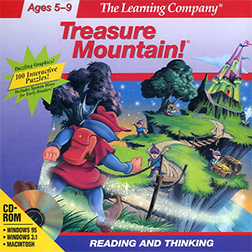
Treasure Mountain! is an educational video game published by The Learning Company in 1990 for DOS, Windows and Macintosh. It teaches children aged five to nine reading, basic math, and logic skills. Treasure Mountain is the third installment of the Super Seekers series.
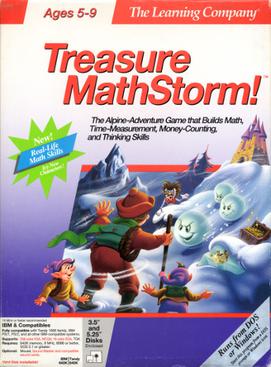
Treasure MathStorm! is an educational computer game intended to teach children ages five to nine mathematical problem solving. This sequel to Treasure Mountain! is the sixth installment of The Learning Company's Super Seekers games and the second in its "Treasure" series.

Fire Emblem: Path of Radiance is a 2005 tactical role-playing video game developed by Intelligent Systems and Nintendo SPD, and published by Nintendo for the GameCube. It is the ninth main installment in the Fire Emblem series, and the third to be released in the west. As with previous installments, gameplay revolves around positioning characters on a battlefield to defeat an opposing force. If characters are defeated in battle, they are removed from the rest of the game.

Pirates of the Caribbean: The Legend of Jack Sparrow is an action-adventure video game developed by 7 Studios and published by Bethesda Softworks for the PlayStation 2 and Microsoft Windows. It features playable levels based on the experiences of Captain Jack Sparrow, voiced by Johnny Depp who portrays him in the movies, after the events of Pirates of the Caribbean: The Curse of the Black Pearl.

Animal Crossing is a social simulation video game series developed and published by Nintendo. The series was conceptualized and created by Katsuya Eguchi and Hisashi Nogami. In Animal Crossing, the player character is a human who lives in a village inhabited by various anthropomorphic animals and can do various activities like fishing, insect catching, and fossil hunting. The series is notable for its open-ended gameplay and use of the video game console's internal clock and calendar to simulate real passage of time.
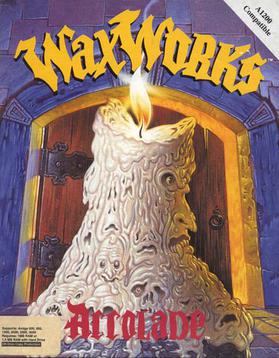
Waxworks is a horror-themed first-person dungeon crawl video game developed by Horror Soft and released in 1992 for Amiga, Macintosh, and DOS.

Running Wild is a racing video game developed by Blue Shift and published by 989 Studios for the PlayStation. It was originally released worldwide on October 7, 1998; the European release was published by Sony Computer Entertainment, 989's parent company. The game was produced by Universal Interactive Studios, who produced Crash Bandicoot and Spyro for Sony and advertised the game as "from the producers of Crash Bandicoot".

Wario is a video game series, a spin-off of the Mario franchise. It comprises various video games created by Nintendo, starring the character Wario. The series began with Wario Land: Super Mario Land 3, the first game to feature Wario as a playable character. The Wario series includes mostly platforming video games and minigame compilations, but also includes other genres.

The Cheetahmen is a video game series created by Active Enterprises starring three anthropomorphic cheetahs. It was introduced in 1991, as part of the Action 52 multi-game cartridge for the NES. It is notable for its main theme, as it was later used as the overworld music in Cat Mario, as well as its extremely low quality, often being cited as one of the worst video games of all time. The Cheetahmen also appear in an unpublished sequel for the NES, Cheetahmen II, and a Sega Genesis title that was again called The Cheetahmen. Cheetahmen III was in development in 1994 for a prototype handheld console by Active Enterprises but is now considered vaporware.
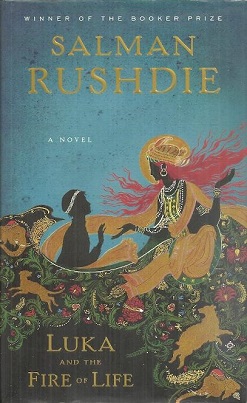
Luka and the Fire of Life is a novel by Salman Rushdie. It was published by Jonathan Cape (UK) and Random House (US) in 2010. It is the sequel to Haroun and the Sea of Stories. Rushdie has said "he turned to the world of video games for inspiration" and that "he wrote the book for his 13-year-old son".
Baldur's Gate III: The Black Hound was a cancelled role-playing video game developed by Black Isle Studios for the Microsoft Windows platform. Announced in 2002 under the codenames FR6 and Project Jefferson, it was planned to be the third main entry in the Baldur's Gate series, utilizing the Dungeons & Dragons 3rd Edition ruleset. The game was set to use a 3D graphics engine developed for the game, rather than the Infinity Engine used for the developer's previous games.
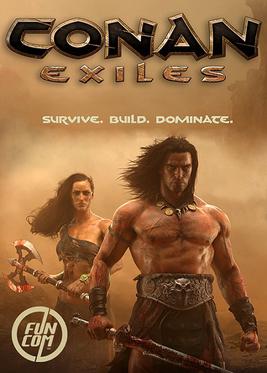
Conan Exiles is a survival video game developed and published by Funcom for PlayStation 4, Windows, and Xbox One. The game is set in the world of Conan the Barbarian, with the custom playable character being rescued by Conan, beginning their journey. Early access versions of the game were released in early 2017, leaving early access on 8 May 2018. An enhanced version of the game for Xbox Series X and Series S released on 8 June 2021.
Reptilian humanoids, or anthropomorphic reptiles, are fictional creatures that appear in folklore, fiction, and conspiracy theories.

















